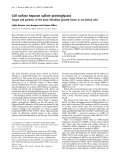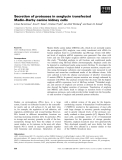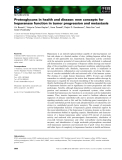
Proteoglycan
-
Bài giảng Nguyên lý hoá sinh: Bài 5 cung cấp cho người đọc những kiến thức như: Monosaccharide và disaccharide (Đường đơn và đường đôi); Polysaccharide (Đường đa); Các dạng đường liên kết: Proteoglycan, Glycoprotein, glycolipid; Carbohydrate là các phân tử thông tin: Mã đường. Mời các bạn cùng tham khảo!
 63p
63p  bapnep06
bapnep06
 27-02-2023
27-02-2023
 12
12
 2
2
 Download
Download
-
In seminiferous tubules, Sertoli cells provide structural and nutritional support for the developing germinal cells. Cellto-cell signaling and cell adhesion require proteoglycans expressed at the cell membrane. A preliminary biochemical and structural approach indicated that cell surface proteoglycans are mostly heparan sulfate proteoglycans (HSPG). Glypican-1, syndecans-1 and -4 were identified using a molecular approach.
 9p
9p  research12
research12
 01-06-2013
01-06-2013
 43
43
 5
5
 Download
Download
-
Decorin is a small leucine-rich chondroitin/dermatan sulfate proteoglycan reported to interact with ®brillar collagens through its protein core and to localize atdandebands of the collagen ®bril banding pattern. Using a solid-phase assay, we have determined the interaction of peptides derivedbyCNBr cleavage of type I and type II collagenwith decorin extracted from bovine tendon and its protein core and with a recombinant decorin preparation.
 10p
10p  research12
research12
 29-04-2013
29-04-2013
 38
38
 3
3
 Download
Download
-
Basic ®broblast growth factor (bFGF) regulates diversi®ed biological functions in rat Sertoli cells. This report demon-strates that bFGF inhibits steroidogenesis in developing rat Sertoli cells. Follicle stimulating hormone (FSH)-stimulated estradiol production was reduced by bFGF. Moreover, the amount of cytochrome P450 aromatase, responsible for the irreversible transformation of androgens into estrogens, is decreased by bFGF at the transcriptional level.
 10p
10p  research12
research12
 23-04-2013
23-04-2013
 32
32
 2
2
 Download
Download
-
Báo cáo khoa học: Human proteoglycan testican-1 inhibits the lysosomal cysteine protease cathepsin L
Testican-1, a secreted proteoglycan enriched in brain, has a single thyropin domain that is highly homologous to domains previously shown to inhibit cysteine proteases. We demonstrate that purified recombinant human testican-1 is a strong competitive inhibitor of the lysosomal cysteine pro-tease, cathepsin L,withaKiof 0.7nM, but it does not inhibit the structurally related lysosomal cysteine protease cathep-sin B. Testican-1 inhibition of cathepsin L is independent of its chondroitin sulfate chains and is effective at both pH 5.5 and7.2.
 8p
8p  tumor12
tumor12
 20-04-2013
20-04-2013
 37
37
 4
4
 Download
Download
-
In the leukemic macrophage cell-line THP-1, a fraction of the secreted matrix metalloproteinase 9 (MMP-9) is linked to the core protein of chondroitin sulfate proteoglycans (CSPG). Unlike the monomeric and homodimeric forms of MMP-9, the addition of exogenous CaCl2 to the proMMP-9/CSPG complex resulted in an active gelatinase due to the induction of an autocatalytic removal of the N-terminal prodomain.
 12p
12p  tumor12
tumor12
 20-04-2013
20-04-2013
 37
37
 3
3
 Download
Download
-
The importance of proteoglycans for secretionof proteolytic enzymes was studied in the murine macrophage cell line J774. Untreated or 4b-phorbol 12-myristate 13-acetate (PMA)-stimulated macrophages were treated with hexyl-b-D-thioxyloside to interfere with the attachment of glycosaminoglycan chains to their respective protein cores. Activation of the J774 macrophages with PMA resulted in increased secretion of trypsin-like serine proteinase activity.
 10p
10p  tumor12
tumor12
 20-04-2013
20-04-2013
 35
35
 3
3
 Download
Download
-
Stromal cell-derived factor-1 (SDF-1)⁄CXCL12, the ligand for CXCR4, induces signal transduction. We previously showed that CXCL12 binds to high- and low-affinity sites expressed by primary cells and cell lines, and forms complexes with CXCR4 as expected and also with a proteoglycan, syndecan-4, but does not form complexes with syndecan-1, syndecan-2, CD44 or beta-glycan. We also demonstrated the occurrence of a CXCL12-independent heteromeric complex between CXCR4 and syndecan-4.
 15p
15p  awards
awards
 06-04-2013
06-04-2013
 38
38
 2
2
 Download
Download
-
The small leucine-rich proteoglycan decorin can bind via its core protein to different types of collagens such as type I and type VI. To test whether decorin can act as a bridging molecule between these collagens, the binding properties of wild-type decorin, two full-length decorin species with single amino acid substitutions (DCN E180K, DCN E180Q), which previously showed reduced binding to collagen type I fibrils, and a truncated form of decorin (DCN Q153) to the these collagens were investi-gated. ...
 0p
0p  awards
awards
 05-04-2013
05-04-2013
 33
33
 2
2
 Download
Download
-
Lactoferrin (Lf), a multifunctional molecule present in mammalian secretions and blood, plays important roles in host defense and cancer. Indeed, Lf has been reported to inhibit the proliferation of cancerous mammary gland epi-thelial cells and manifest a potent antiviral activity against human immunodeficiency virus and human cytomegalo-virus. The Lf-binding sites on the cell surface appear to be proteoglycans and other as yet undefined protein(s).
 15p
15p  dell39
dell39
 03-04-2013
03-04-2013
 46
46
 5
5
 Download
Download
-
This work investigated the kinetics of catabolism and the catabolic fate of the newly synthesized 35 S-labelled proteo-glycans present in explant cultures of tendon. Tissue from the proximal region of bovine deep flexor tendon was incu-bated with [ 35 S]sulfate for 6 h and then placed in explant cultures for periods of up to 15 days. The amount of radi-olabel associatedwithproteoglycans and free [ 35 S]sulfate lost to themediumand retained in thematrixwas determined for each day in culture.
 9p
9p  dell39
dell39
 03-04-2013
03-04-2013
 22
22
 3
3
 Download
Download
-
Madin–Darby canine kidney (MDCK) cells, which do not normally express the proteoglycan (PG) serglycin, were stably transfected with cDNA for human serglycin fused to a polyhistidine tag (His-tag). Clones with differ-ent levels of serglycin mRNA expression were generated. One clone with lower and one with higher serglycin mRNA expression were selected for this study.
 12p
12p  dell39
dell39
 27-03-2013
27-03-2013
 41
41
 4
4
 Download
Download
-
This study investigated the effects of two highly sulfated polysaccharides, calcium pentosan polysulfate and heparin, on the loss of newly synthesized proteoglycans from the matrix of explant cultures of bovine tendon. The tensional region of deep flexor tendon was incubated with [ 35 S]sulfate for 6 h and then placed in culture for up to 15 days.
 10p
10p  inspiron33
inspiron33
 25-03-2013
25-03-2013
 55
55
 3
3
 Download
Download
-
In the absence of serglycin proteoglycans, connective tissue-type mast cells fail to assemble mature metachromatic secretory granules, and this is accompanied by a markedly reduced ability to store neutral proteases. However, the mechanisms behind these phenomena are not known.
 12p
12p  inspiron33
inspiron33
 23-03-2013
23-03-2013
 32
32
 3
3
 Download
Download
-
Decorin is a multifunctional small leucine-rich proteoglycan involved in the regulation of collagen fibrillogenesis. In patients with a variant of Ehlers– Danlos syndrome, about half of the secreted decorin lacks the single gly-cosaminoglycan side chain.
 10p
10p  media19
media19
 04-03-2013
04-03-2013
 52
52
 3
3
 Download
Download
-
The expression of proteoglycans (PGs), essential macromolecules of the tumor microenvironment, is markedly altered during malignant transforma-tion and tumor progression. Synthesis of stromal PGs is affected by factors secreted by cancer cells and the unique tumor-modified extracellular matrix may either facilitate or counteract the growth of solid tumors.
 20p
20p  viettel02
viettel02
 19-02-2013
19-02-2013
 53
53
 4
4
 Download
Download
-
Heparanase is an endo-b-D-glucuronidase capable of cleaving heparan sul-fate side chains at a limited number of sites, yielding heparan sulfate frag-ments of still appreciable size. Importantly, heparanase activity correlates with the metastatic potential of tumor-derived cells, attributed to enhanced cell dissemination as a consequence of heparan sulfate cleavage and remod-eling of the extracellular matrix and basement membrane underlying epithe-lial and endothelial cells.
 14p
14p  viettel02
viettel02
 19-02-2013
19-02-2013
 44
44
 3
3
 Download
Download
-
Proteolytic processes in the extracellular matrix are a major influence on cell adhesion, migration, survival, differentiation and proliferation. The syndecan cell-surface proteoglycans are important mediators of cell spread-ing on extracellular matrix and respond to growth factors and other bio-logically active polypeptides.
 14p
14p  viettel02
viettel02
 19-02-2013
19-02-2013
 46
46
 4
4
 Download
Download
-
The small leucine-rich proteoglycans (SLRPs) are involved in many aspects of mammalian biology, both in health and disease. They are now being rec- ognized as key signaling molecules with an expanding repertoire of molecu- lar interactions affecting not only growth factors, but also various receptors involved in controlling cell growth, morphogenesis and immunity.
 12p
12p  viettel02
viettel02
 19-02-2013
19-02-2013
 47
47
 3
3
 Download
Download
-
Parathyroid hormone (PTH)(1–34), which has been established to have a dual effect on bone metabolism, was recently found to regulate osteosarcoma cell migration. A significant part of the bone anabolic action of PTH(1–34) is attributed to fibroblast growth factor (FGF)-2 stimulation.
 11p
11p  cosis54
cosis54
 09-12-2012
09-12-2012
 60
60
 2
2
 Download
Download
CHỦ ĐỀ BẠN MUỐN TÌM

































